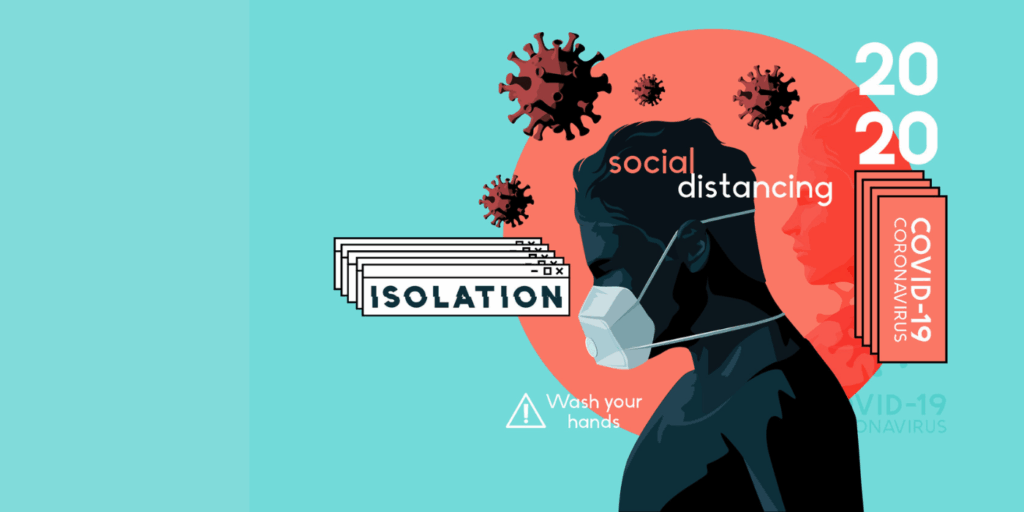
When the COVID-19 outbreak occurred, the world stopped. We quantified the loss in terms of lives, livelihoods, and mobility. However, a less visible aspect was unfolding: the global collapse of mental health. While lockdowns lifted and vaccines rolled out, the emotional and psychological scars continue to linger. At this moment, we’re defying not just a natural contagion but the enduring earthquake it left on global internal well-being.

Universal Disruptions, Unequal Impact
Though the virus did not play favourites, its psychological effects were decidedly unequal. Everyone was fearful, uncertain, and isolated, but some populations were disproportionately affected. Health care professionals, repeatedly exposed to trauma, burnout, and moral harm, were emotionally drained (Greenberg et al., 2020). Students had interrupted education, social isolation, and growing anxiety (UNESCO, 2021). People with ongoing mental illness commonly discover their support systems broken or unavailable. Survivors of domestic abuse were confined in unsafe homes, and low-income families bore the double load of job insecurity and emotional pain. Even individuals who had never faced mental health issues earlier were found to be overwhelmed. Anxiety, depression, and post-traumatic stress disorder cases across the world skyrocketed. The World Health Organisation (WHO) (2022) reported that the pandemic prompted a 25% rise in anxiety and depression across the globe in just one year alone.
The pandemic did not create the mental health crisis in a vacuum; it maximised existing stressors and created new ones. Isolation took away people’s emotional support networks. Bereavement was compounded when individuals were not able to hold funerals or bid farewell (Van Schaik et al., 2022). Unpredictability of employment, disruptions in education, and unexpected financial uncertainties precipitated chronic stress. Home environments, rather than being secure havens, became charged with emotional tensions for many. Also, the media-induced fear cycle, with 24/7 breaking news alerts, disinformation, and mortality count numbers, heightened worry and powerlessness. The digital divide widened inequalities, with huge numbers of people excluded from being able to access online therapy, distance learning, or virtual communities. COVID-19 callously laid bare the long-neglected gaps in mental health infrastructure. In India, mental health has long been low-budgeted and low-priority, receiving less than 1% of the country’s health budget. India only has 0.75 psychiatrists for every 100,000 individuals (Jha, 2023), well short of the WHO’s standard. Mental health services had hitherto been urban-focused, with rural and poor communities excluded from the debate. There was a lack of knowledge among a lot of individuals regarding emotional distress or channels through which to get assistance because of stigma or unavailability.

Progress Under Pressure: Infrastructure That Emerged
Amid this chaos, however, necessity became a powerful catalyst. The crisis forced governments, institutions, and communities to act. India launched the National Tele-Mental Health Programme (Tele-MANAS) in 2022 to make mental health services more accessible (Ministry of Health and Family Welfare [MoHFW], 2022). Online platforms like YourDOST, MindPeers, and Wysa emerged as virtual therapy hubs. These platforms bridged geographical gaps, provided anonymity, and normalised conversations around therapy. Workplaces introduced mental health days, check-ins, and Employee Assistance Programs (EAPs). Educational institutions began integrating wellness sessions and peer support groups. Even pop culture and social media saw influencers opening up about depression, anxiety, and burnout, slowly shifting public narratives.

Rebuilding Resilience: A Collective Responsibility
While there was a real need for systemic reform, healing happened just as well through community, rituals, and everyday micro-moments. People found solace in shared online spaces-from journaling circles to virtual book clubs; from Instagram pages about mental health to Instagram Live discussions with mental health professionals. Youth initiatives began to spread awareness, address myths, and provide peer support. Schools and colleges instituted mental health helplines and resilience-building workshops. Even cultural rituals were at work. Online memorials helped people grieve together. Shared family meals, goodnight texts, and funny reels were an anchor during drift. These tiny acts of love and connection served as emotional lifeboats. Importantly, vulnerability began to get reframed. Not an act of seeking help; not an outcast. Whispering about therapy was over. Panic attacks were being discussed openly, breakdowns, and healing journeys.

Moving Forward: From Crisis to Change
The mental health emergency is far from over, but it has started some vital conversations. Next comes translating awareness into action. Policymakers need to expand mental health budgets, decentralise services, and introduce emotional well-being into public health courses. Schools should have emotional literacy programs and routine check-ins. The workplace needs to treat mental health not as a benefit but as a basic right. We need more community-based models, especially for underserved areas, and must invest in preventive care, not just curative solutions. Furthermore, we must see emotional resilience as a shared, not individual, process. The aim is not for people to “bounce back” alone but to move forward together, more emphatically and equitably.
COVID-19 might be retreating into the background of our news cycle, but its emotional legacy continues to linger in the fabric of daily life. The pandemic broke many things: our routines, a sense of safety, and our connections. But it also laid bare our participatory need for empathy, support, and emotional equilibrium. The post-pandemic mental health crisis is not a passing phase. It’s a reckoning. It will be a process, but with intention, community, and ongoing care, it can be done. We need to listen, create space, and build a world where emotional health isn’t an afterthought but an anchor.
Written by – Arya Jagdish Sawant
Edited by – Rubina Shaikh
The post The Emotional Pandemic We’re Yet to Cure appeared first on The Economic Transcript.


